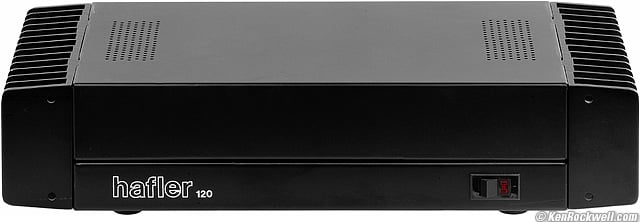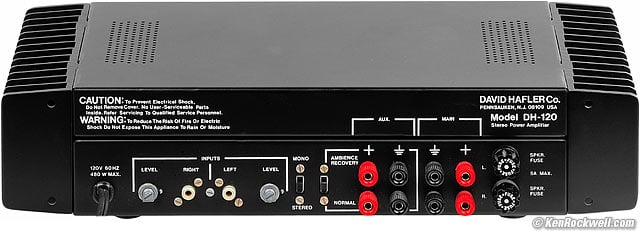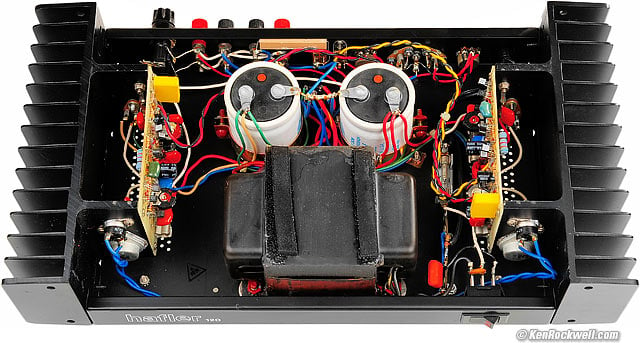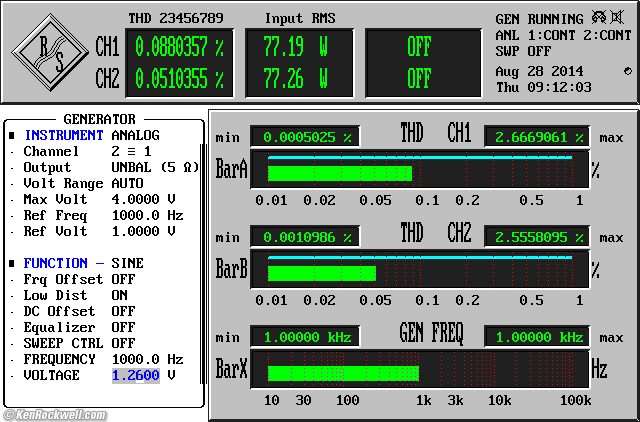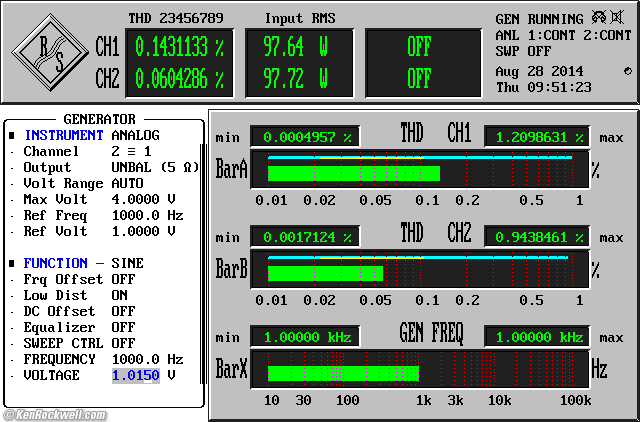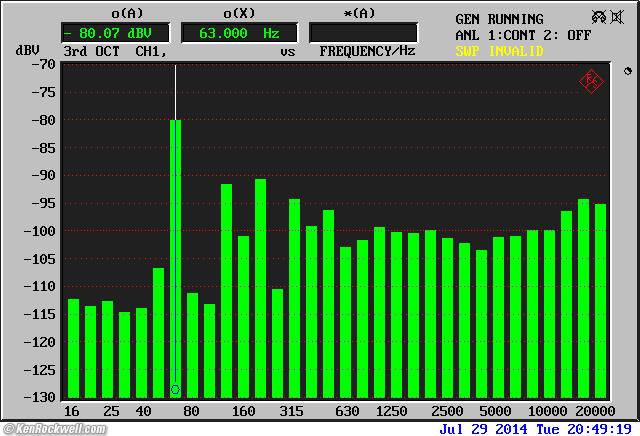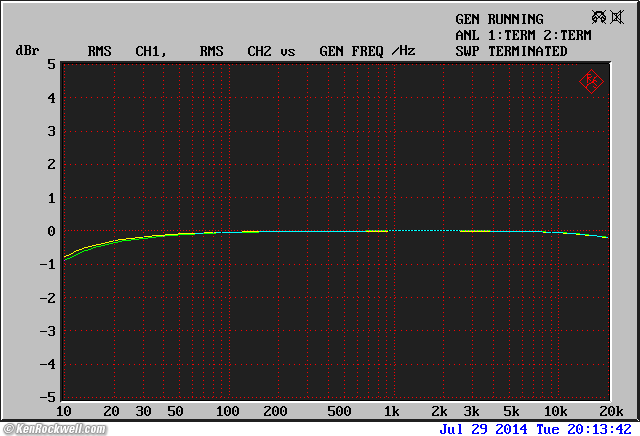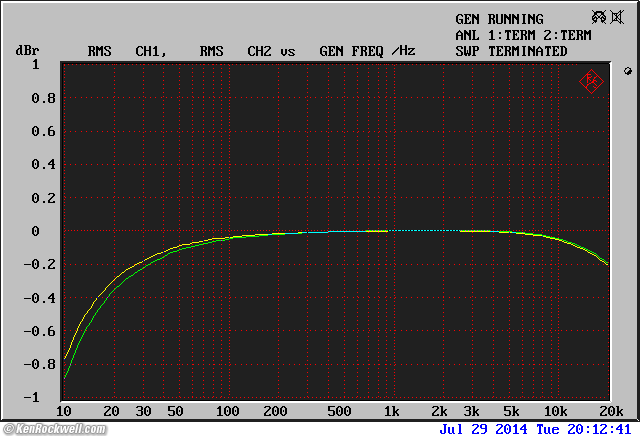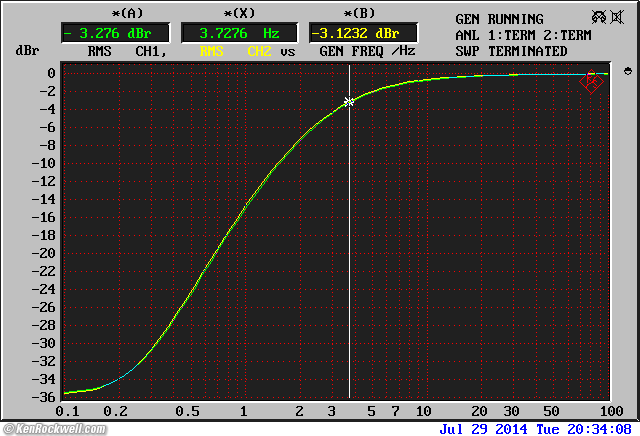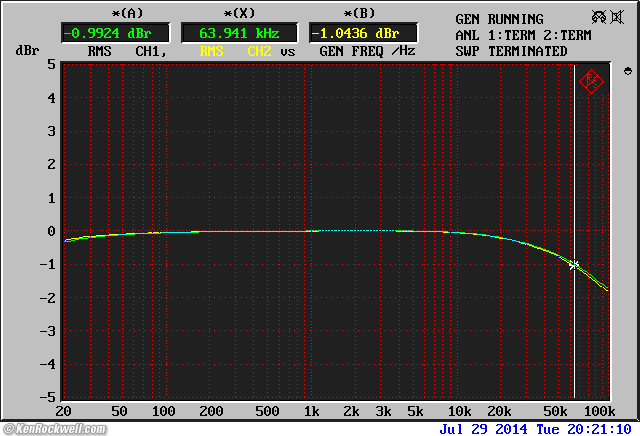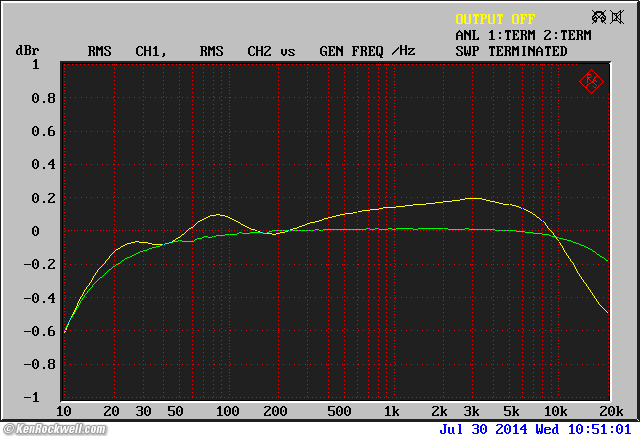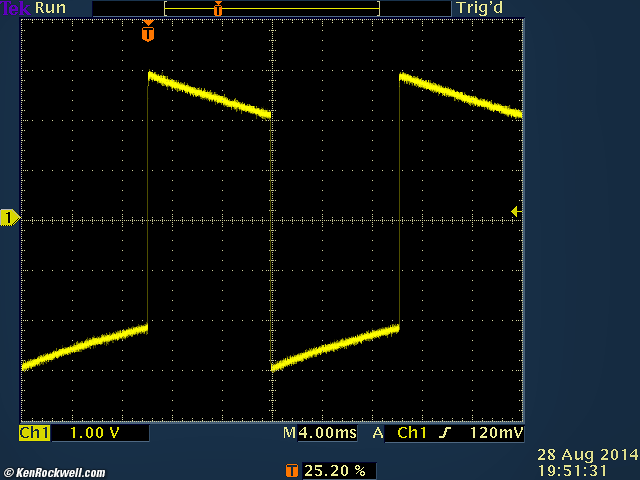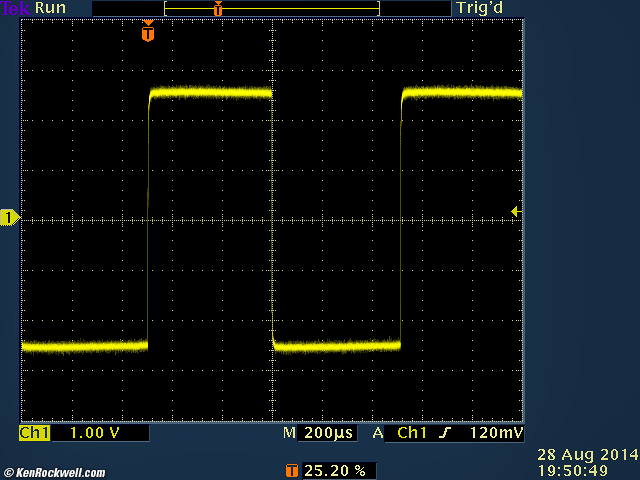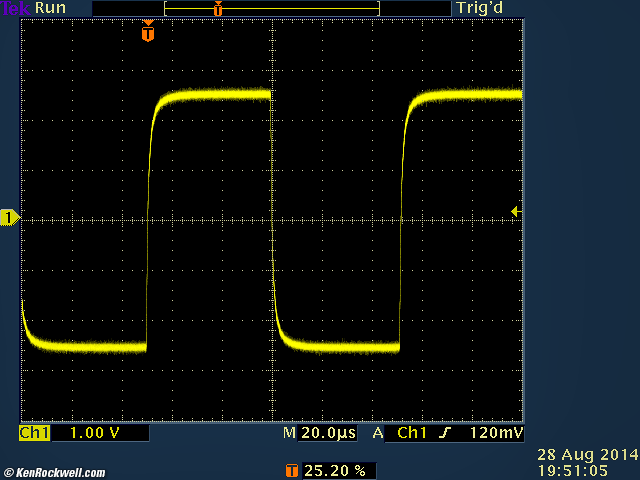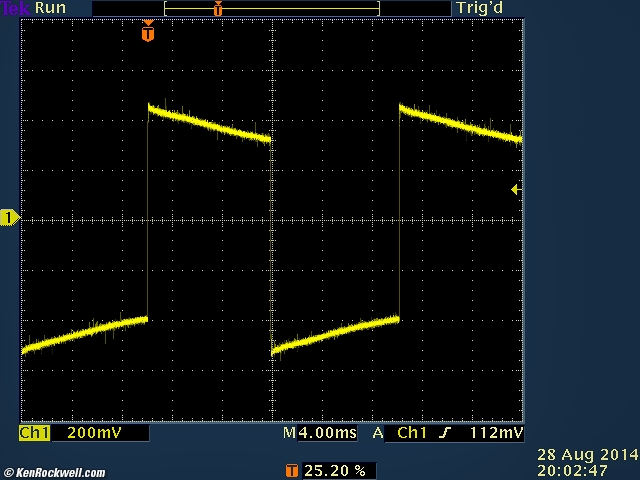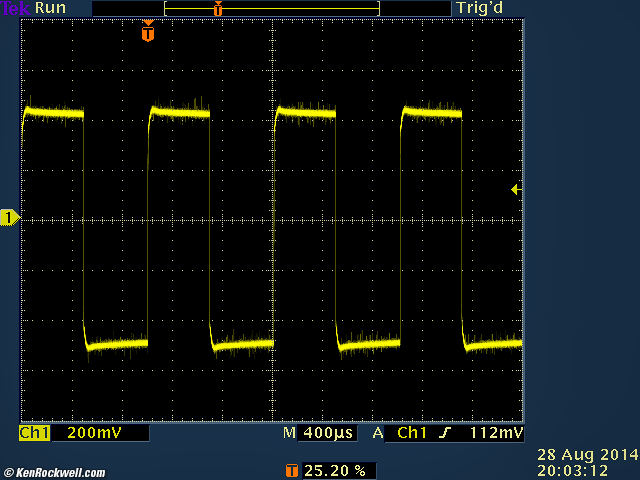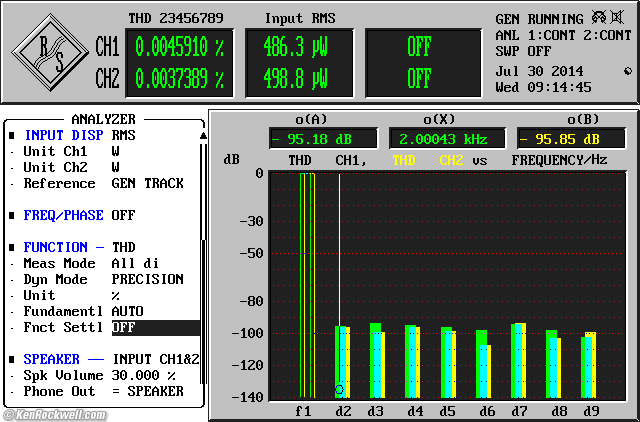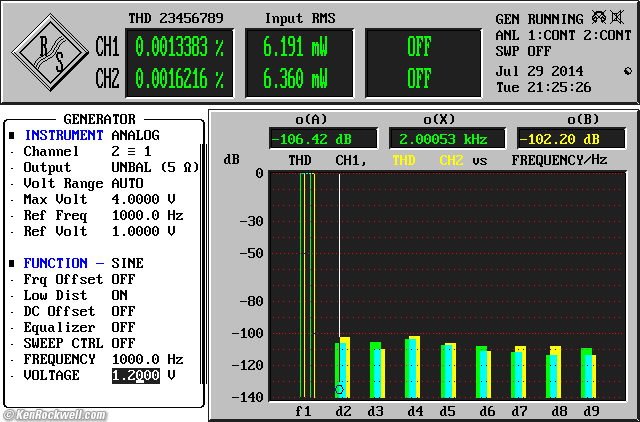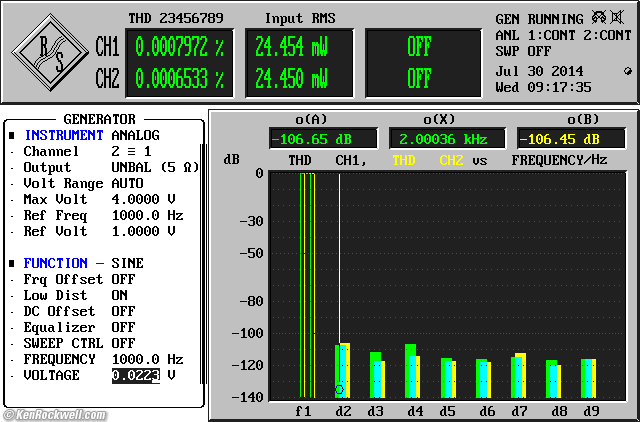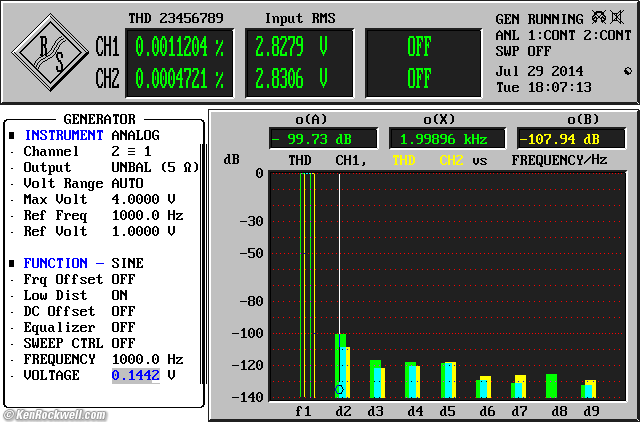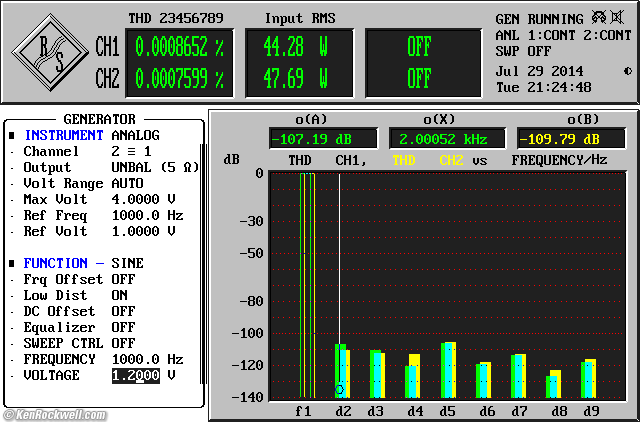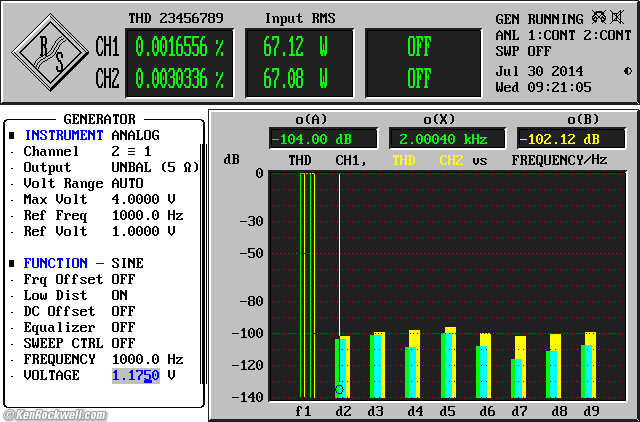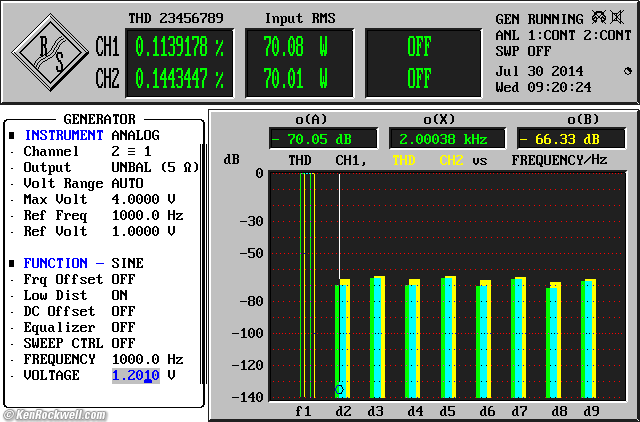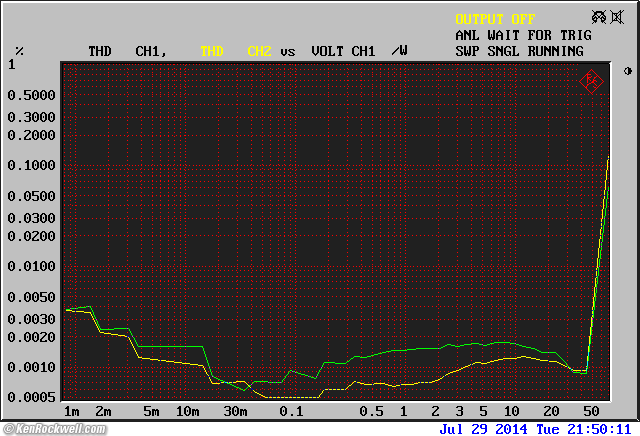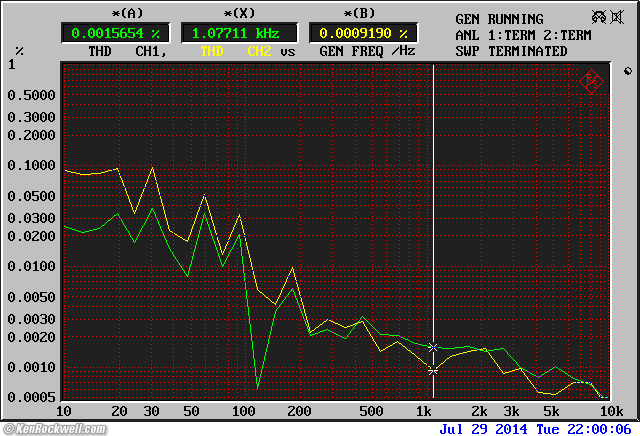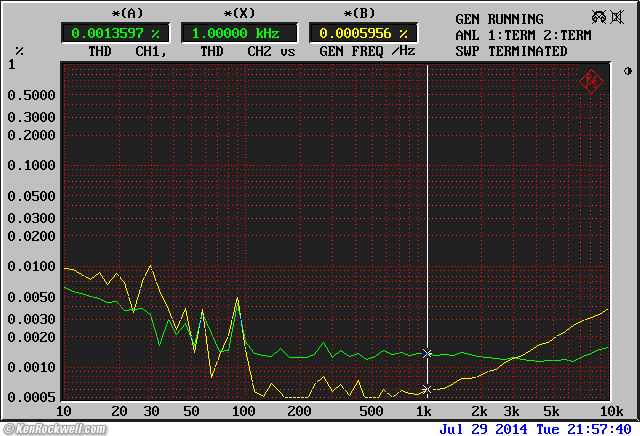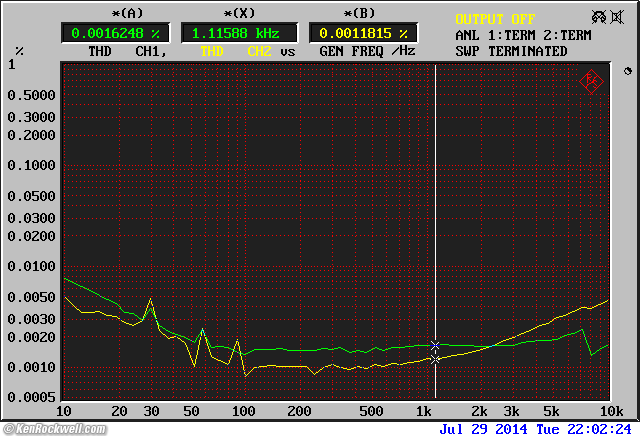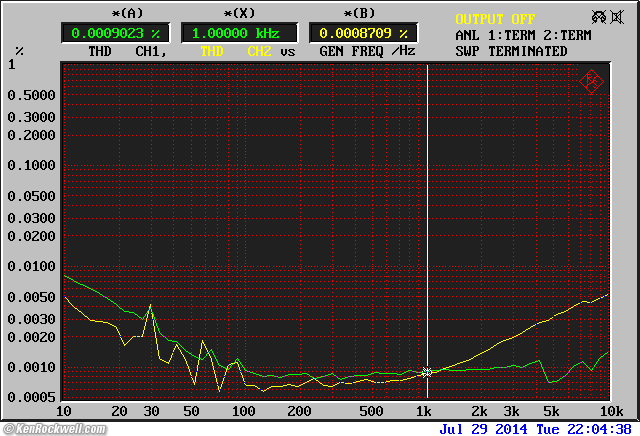Home Donate New Search Gallery Reviews How-To Books Links Workshops About Contact
Hafler DH-120
60 WPC MOSFET Stereo Amplifier
Made in USA (1984-1989)
© 2014 KenRockwell.com. All rights reserved.
Intro Specifications Measurements Compared
Hafler DH-120 (rated 60 watts per channel into 8Ω, 18 lbs./8.2 kg, measured 32 watts idle power draw, about $100 used). enlarge. I got this mine at this link directly to them at eBay (see How to Win at eBay).
This free website's biggest source of support is when you use those or any of these links to approved sources when you get anything, regardless of the country in which you live — but I receive nothing for my efforts if you take the chance of buying elsewhere. I get no government hand-outs and run no pledge drives to support my research, so please always use any of these links to approved sources for the best prices, service and selection whenever you get anything. Thanks for helping me help you! Ken.
Rear, Hafler DH-120. enlarge.
inside the Hafler DH-120. enlarge.
August 2014 Hafler reviews audio reviews all reviews
Introduction top
Intro Specifications Measurements Compared
The Hafler DH-120 is a very high quality 60 watts-per-channel MOSFET class AB stereo power amplifier. MOSFETs are solid-state devices that work on principals more similar to vacuum tubes than bipolar transistors — and it sounds great! This 30-year-old sample easily put out 77 WPC continuous and 118 W burst power into 8Ω.
30 years ago when the DH-120 was introduced, it astounded the world, as did its older and larger brothers, the DH-200 and DH-220, in having performance so high that it exceeded the abilities of most laboratory equipment of its day. It was also reasonably priced, making all these Hafler amplifiers astounding both for their incredible performance and unheard of prices.
Today I have the modern laboratory equipment to allow me to test exactly how good is this 30-year old sample, purchased from a random stranger over eBay.
Like most made-in-USA audio gear, it easily outperforms its rated specifications, easily putting out 72 WPC continuous and 115 WPC in 10 mS bursts at clipping into 8Ω, and only has about 0.001% THD at most power levels — and this is testing a 30-year-old amplifier!
It tests well, and sounds even better. It has loads of smooth, detailed sound, deep, tight bass and laser-sharp stereo imaging with an ultra-tight center image as tested with the B&W Matrix 802 Series III loudspeakers.
The DH-120 was sold as a kit or fully assembled. The kits came with the two amplifier modules completely assembled and tested; kit assembly was assembling the case then wiring the power supplies, switches and connectors together.
Assembled versions came with a full 3-year warranty, and the kits came with a 1-year warranty on parts. In reality, I built a DH-200 from a kit in 1981, and about 15 years later I had a small problem and phoned Hafler. They recognized the problem and sent me two new transistors, free of charge. That fixed it and it's run perfectly ever since.
The amplifier tested here was made in about 1985 and I'm testing it today in 2014. It still easily exceeds its specifications nearly 30 years later, and I doubt it's ever been serviced.
This amplifier is from the very pinnacle of home High Fidelity. Products got better and better ever since home amplifiers were invented in the 1920s, but video took over home entertainment by the late 1980s, and home Hi-Fi equipment never evolved past this stage. Newer Hafler amplifiers, and the home audio market in general, has been neglected for lack of interest ever since the VCR became affordable to everyone in the late 1980s. There are newer amplifiers, but few are better than this Hafler DH-120.
David Hafler was one of the founders of Dynaco in 1954, and started the Hafler company in 1977.
Circuit Design
It's a traditional class AB linear power amplifier in a sheet metal steel case.
It has a traditional unregulated linear power supply with a big power transformer in the middle of the case, a bridge rectifier and two Sangamo 6,600 µF 60V capacitors that run at ±54 VDC at 120 VAC input, or ±52 VDC at 115 VAC as measured.
The "loose" regulation of the power supply gives it much greater burst power than continuous (perfect for music), and also means that power output doesn't completely double as speaker impedance halves.
It has four power MOSFETs (2 per channel) in TO-3 packages mounted to two big anodized aluminum heat sinks on opposite sides of the case.
There's a neon pilot light in the power switch.
It has a clever passive "Ambiance Recovery" circuit built in. Add a second pair of speakers and it will synthesize a surround sound field all by itself. It's the classic Hafler/Dynaco L-R passive synthesizer, but without any controls or adjustments.
The DH-120 has one 5 ampere slow-blow power-input fuse, and 4A fast-blow fuses on the B+ and B- rails of each of the two power amp modules.
It has speaker fuses to protect your speakers from you doing something stupid. Most amplifiers don't have speaker fuses. Unlike the DH-200, the speaker fuses aren't inside the feedback loop.
Specifications top
Intro Specifications Measurements Compared
Output Power
Stereo
Less than 0.009% THD at any power level up to 60 watts per channel, both channels driven, from 20-20,000 Hz.
Mono (one channel only)
150 watts into 8Ω.
Audio Input
One stereo pair of 1/4" RCA jacks with individual potentiometers.
22 kΩ.
1.1 V RMS input for 60 watts into 8Ω.
Audio Output Connectors
Standard 5-way binding posts on standard 3/4" centers.
Total four pairs or 8 posts.
SMPTE Intermodulation Distortion
< 0.005% from 1 - 60 watts into 8Ω.
THD at 60 WPC into 8Ω (typical)
20 Hz: 0.002%
1 kHz: 0.002%
20 kHz: 0.006%
Frequency Response into 8Ω
10 - 40,000 Hz at 60 watts, +0, -0.5 dB.
4 - 200,000 Hz at -3 dB at 1 watt.
Crosstalk
> 75 dB at 20 Hz.
> 85 dB at 1 kHz.
> 65 dB at 20 kHz.
Signal to Noise Ratio
>100 dB unweighted, referred to 60 watts.
This means < -82.2 dBW or < 219 µV or < -73.2 dBV noise output.
Damping Factor
100 at up to 1 kHz into 8Ω.
50 at up to 10 kHz into 8Ω.
Rise Time
2 µS from 10% to 90% with a 45 V p-p 10 kHz square wave.
Slew Rate
30 V/µS with a 45 V p-p 10 kHz square wave.
Semiconductors
4 power MOSFETs: one pair of complementary Hitachi 2SK134 and 2SJ49 lateral MOSFETs per channel.
Each of these power MOSFETs was individually tested, graded and sorted by Hafler. Each was stamped with a number from one to five and assembled accordingly into amplifier modules.
22 transistors.
23 diodes.
8 Zener diodes.
1 bridge rectifier.
Power Input
120 VAC, 60 Hz.
Rated 480 W maximum.
Actual power consumption is much less.
Quality
Made in the United States of America (Pennsauken, New Jersey).
Packaging
Corrugated cardboard box.
Amplifier supported by cleverly multiple-folded inner corrugated cardboard insert.
Size
3¼" x 15¾" x 9 inches, HWD, including rear connectors but excluding feet and power switch.
3¾" x 15¾" x 9 inches, HWD, including rear connectors and feet but excluding power switch.
Allow a couple of extra inches at the rear for cables and ¼" at the front for the power switch.
Weight
18 pounds (8.2 kg).
20 pounds (9.2 kg) shipping weight.
Price, USA
1984: new model, price not listed.
1985: $320; $260 kit, list prices.
1986: $320; $260 kit, list prices.
1987: $375; $325 kit, list prices.
1988: $425; $325 kit, list prices.
1989: $349. SE-120 appears at $325, list prices.
1990: DH-120 gone, SE-120 is $325, list prices.
2014: about $100 used.
Measurements top
Intro Specifications Measurements Compared
Gain Input Levels Channel Balance Power Output
Damping Factors Noise SNR DC Offset
Frequency Response Square Waves THD DFD
Actual Power Consumption Mono Operation
These measurements were made with a $50,000 Rohde & Schwarz UPL laboratory analyzer. The traces from the Rohde & Schwarz UPL laboratory analyzer are color coded for the Left Channel and for the Right Channel. When they don't lie on top of each other, it's due to channel imbalance. When they do lie on top of each other, the trace turns blue.
Unless otherwise specified, all measurements are RMS at 1 watt continuous output per channel at 1 kHz with an 8 Ω load, both channels driven with 120.0 VAC 60 Hz supply.
Gain measurements top
Stereo
25.844 dB left, 25.883 dB right.
With the pots halfway down, gain is 17 dB, and off when all the way down.
MONO Mode
In MONO mode, gain is 31.80 dB. (Measured separately, the channels measure 25.894 and 25.897 dB, which is extremely tight matching!)
Input Levels measurements top
Stereo 8Ω
144 mV for 1 W output.
454 mV for 10 W output.
1.0133 V for 50 W output.
1.110 V for 60 W output.
1.260 V for 77 W output at 0.1% THD.
1.580 V for 118 W output in 10mS bursts at clipping.
Stereo 4Ω
102.3 mV for 1 W output into 4Ω.
1.015 V for 97 W output at 0.1% THD into 4Ω.
1.450 V for 193 W output in 10mS bursts at clipping into 4Ω.
MONO Mode
72.7 mV input for 1 W output into 8Ω.
53.1 mV for 1W into 4Ω at 0.0067% THD.
583 mV for 117W into 4Ω at 0.1% THD.
1.015 V for 190 W into 8Ω at 0.1% THD.
Channel Balance measurements top
The channels are only 0.038 dB off, which is perfect enough.
It's easy to trim these to match to within ±0.001 dB with a finger on one of the rear pots.
Power Output measurements top
All are continuous RMS measurements at 0.1% THD at 1 kHz into 8Ω unless otherwise noted:
Stereo 8Ω
DH-120 at clipping into 8Ω at 1 kHz.
77 watts per channel into 8Ω, both channels driven continuously at 1 kHz.
Burst Power
118 W into 8Ω at clipping in 10ms bursts of 1 kHz at one burst per second.
Stereo 4Ω
DH-120 at clipping into 4Ω at 1 kHz.
97 watts per channel into 4Ω, both channels driven continuously at 1 kHz.
Burst Power
193 W into 4Ω at clipping in 10ms bursts of 1 kHz at one burst per second.
Mono
190 W continuous into 8Ω at 0.1% THD.
117 W continuous into 4Ω at 0.1% THD.
Damping Factors measurements top
Output Source Impedance |
4Ω Damping Factor |
8Ω Damping Factor |
|
50 Hz |
83.8 mΩ |
47.7 |
95.5 |
1 kHz |
83.8 mΩ |
47.7 |
95.5 |
20 kHz |
345 mΩ |
11.6 |
23 |
Output Noise measurements top
DH-120 noise spectral analysis.
A Weighted |
Unweighted |
|
Left |
-87.5 dBV A |
-79 dBV |
Right |
-89.2 dBV A |
-84 dBV |
Signal to Noise Ratio (SNR) measurements top
97.3 dB A-weighted SNR (15.9 effective bits) referred to 1 watt into 8Ω (2.83 V or +9.031 dBV).
115.3 dB A-weighted SNR (18.8 effective bits) referred to 60 watts into 8Ω (21.91 V or +26.81 dBV).
Output DC Offset measurements top
-44.6 mV left, -46.4 mV right.
Frequency Response measurements top
DH-120 frequency response into 8Ω.
DH-120 frequency response into 8Ω, expanded scale.
This is swell. I'd like to see no droop at 20 Hz, but I can't complain too loudly about a a third of a dB loss at 20 Hz.
Here's a closer look at the infrasonic response. It's about 8 dB/octave and -3dB at 3.7 Hz:
DH-120 infrasonic frequency response into 8Ω, 1 - 20,000 Hz.
The high end is perfect. It's rolled-off by only 1 dB at 64 kHz.
Let's look out to 110 kHz:
DH-120 ultrasonic frequency response into 8Ω, 20 - 110,000 Hz.
This is driving an 8Ω resistor, which doesn't count in the real world. Let's see what it does driving a real loudspeaker:
DH-120 driving an 8Ω resistor and driving a B&W Matrix 805 loudspeaker (yellow).
Marvelous, there's only a ±0.2 dB variation.
Square Waves measurements top
50 Hz square wave. (HP 209A, Tek TDS3052, Tek P6139A)
1 kHz square wave. (HP 209A, Tek TDS3052, Tek P6139A)
10 kHz square wave. (HP 209A, Tek TDS3052, Tek P6139A)
50 Hz square wave driving a B&W Matrix 805 loudspeaker. (HP 209A, Tek TDS3052, Tek P6139A)
1 kHz square wave driving a B&W Matrix 805 loudspeaker. (HP 209A, Tek TDS3052, Tek P6139A.)
THD: 0.001% (-100 dB) measurements top
All these THD measurements are measuring pure distortion components only (THD only), not noise and distortion (THD+N). THD+N numbers would be worse than THD alone shown here.
Harmonic Distortion Components at 500 microwatts
DH-120 harmonic distortion content at 500 µW.
Perfect! even at nearly zero output (one-half of one one-thousandth of a watt), there's only 0.004% THD.
Harmonic Distortion Components at 6 milliwatts
DH-120 harmonic distortion content at 6 mW.
At only 6 milliwatts it's just about down to the same THD as at much higher power levels. This is superb.
Harmonic Distortion Components at 24 milliwatts
DH-120 harmonic distortion content at 24 mW.
At 24 milliwatts, where much of the inner detail of music lies, distortion is vanishing at only 0.0007%. You can't get that from crappy class-D amplifiers!
Harmonic Distortion Components at 1 watt
DH-120 harmonic distortion content, 1 kHz at 1 watt, 8Ω load.
Magnificent, the distortion is mostly musical second harmonic distortion, just like tube amplifiers, but an order of magnitude or two less!
Harmonic Distortion Components at 45 watts
DH-120 harmonic distortion content at 45 W.
Nearly no distortion at nearly full power.
Harmonic Distortion Components at 60 watts
DH-120 harmonic distortion content at 60 W.
Nearly no distortion at full rated power. No clipping here!
Harmonic Distortion Components at 67 watts
DH-120 harmonic distortion content at 67 W.
It's started to clip. You'll see how all the harmonics have equal levels.
This is with a low power line voltage of about 113 VAC; it will have much less distortion at 120 VAC.
Harmonic Distortion Components at 70 watts
DH-120 harmonic distortion content at 70 W.
This is at 0.1% THD with a low power supply line voltage, which is the threshold of where I can hear clipping on pure tones. This would be at 77 W at 120 VAC with the same distortion.
THD versus Power into 8 Ω
DH-120 THD versus power output at 1 kHz, 8Ω load.
A summary of what I've just shown. Distortion is in the 0.001% range until about 70 W; this is a coarse plot that makes it appear to start climbing earlier than it actually does.
THD versus Frequency into 8 Ω
DH-120 THD versus frequency at 10 milliwatts, 8Ω load.
This is lumpy due to 60 Hz hum, which is interpreted as distortion at 30, 60, 90 and 180 Hz. Likewise, noise is boosting the readings at low frequencies.
DH-120 THD versus frequency at 1 watt, 8Ω load.
DH-120 THD versus frequency at 10 watts, 8Ω load.
DH-120 THD versus frequency at 50 watts, 8Ω load.
19+20 kHz Difference-Frequency Distortion (DFD)
per DIN IEC 268-3 or 118:
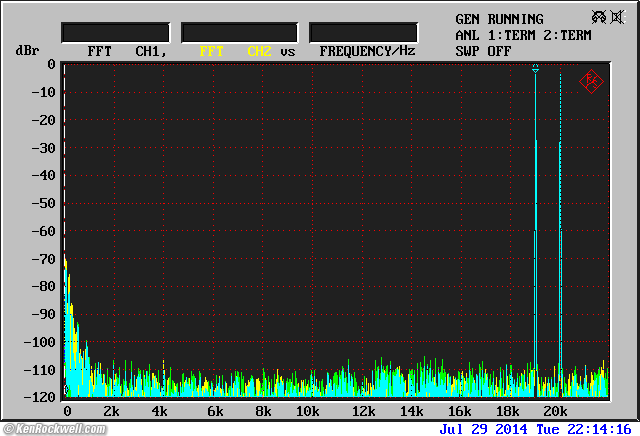
DFD at 100 mW RMS total output.
This isn't distortion, it's noise.
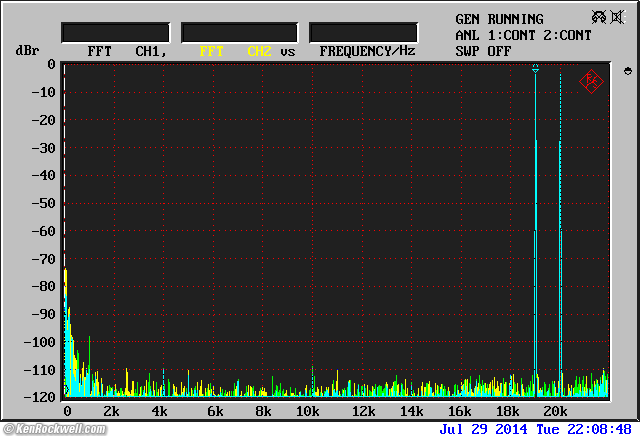
DFD at 1 W RMS total output.
The 1 kHz component is at -99 dB, excellent.
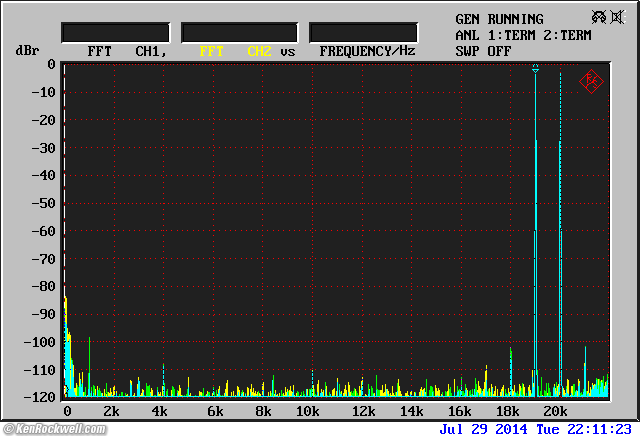
DFD at 10 W RMS total output.
The 1 kHz component is still at -99 dB, which is excellent.
The close-in 18 kHz and 21 kHz skirts are at -101 dB, which are also swell.
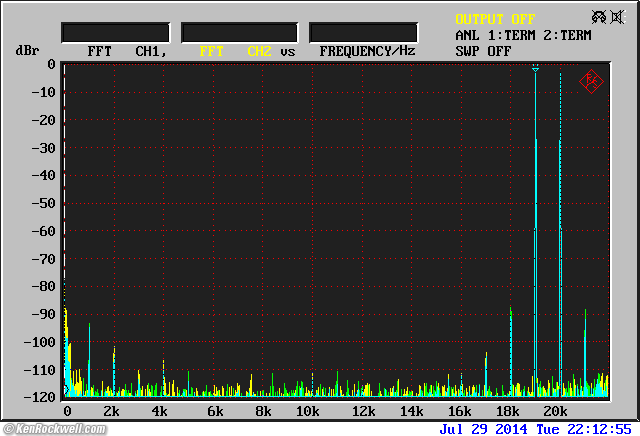
DFD at 35 W RMS total output.
The 1 kHz component is at -92 dB, which is excellent.
The close-in 18 kHz and 21 kHz skirts are at -90 dB, which are also swell at this high power level.
Actual Power Consumption measurements top
The DH-120 runs moderately warm. It's always comfortable to touch and never gets hot if well ventilated.
Output |
Power Consumption |
Efficiency |
Power off |
zero. |
n/a |
Idle, cool |
37.4 W (0.41 A) |
0% |
Idle, warm |
34.2 W (0.38 A) |
0% |
1 WPC |
51.8 W (0.57 A) |
4% |
10 WPC |
128 W (1.36 A) |
5.6% |
50 WPC |
256 W (2.61 A) |
39.0% |
60 WPC |
279 W (2.82 A) |
43.0% |
77 WPC |
312 W (3.14 A) |
49.4% |
97 WPC (4Ω) |
455 W (4.37 A) |
42.6% |
Monophonic (Bridged) Operation measurements top
Gain is 31.80 dB in MONO.
72.7 mV input gives 1 W output into 8Ω.
53.1 mV input gives 1W into 4Ω at 0.0067% THD.
583 mV gives 117 W into 4Ω at 0.1% THD.
1.015 V gives 190 W into 8Ω at 0.1% THD.
The DH-120 doesn't like driving 4Ω in MONO mode. This is because each channel is really driving only 2Ω, and this is not optimum for continuous power since the supplies sag. I didn't test burst power here, but it might be phenomenal - or I might blow up my amplifier. I didn't try.
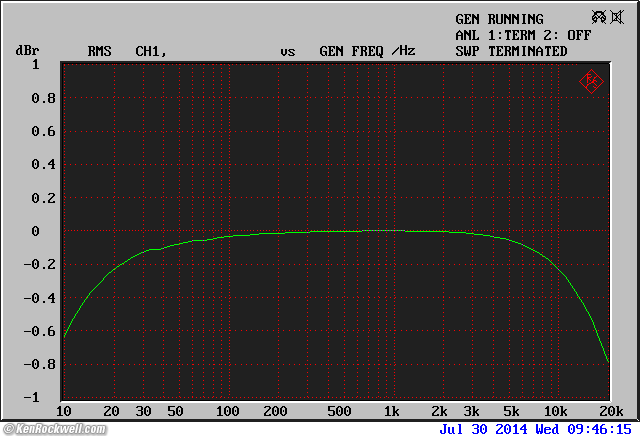
DH-120 frequency response driving 8Ω in MONO mode.
Low frequency response is unchanged, but the increasing output impedance at high frequencies drops the 20 kHz response a little bit compared to stereo operation since each channel is now effectively seeing 4Ω instead of 8Ω.
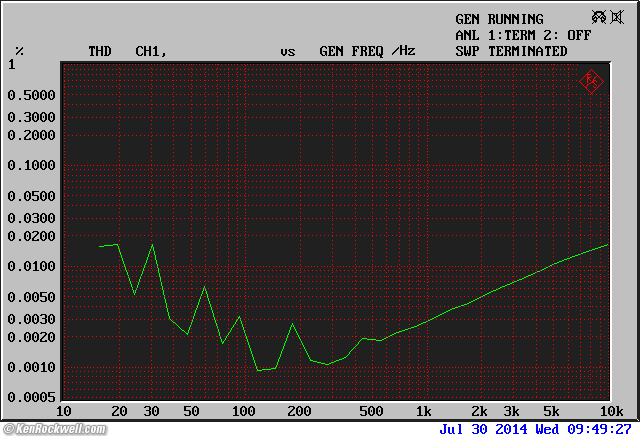
DH-120 THD driving 8Ω in MONO mode at 1 watt.
Distortion is about the same as the usual stereo mode.
Compared top
Intro Specifications Measurements Compared
The DH-120 is a smaller version of the DH-220 (110 WPC) of 1982. The DH-220 was a slightly more powerful version of the DH-200 of 1979 (100 WPC). The DH-500 was the beastly 255 WPC version.
The DH-220 and DH-120 have rounded heat sink fins as you can see at the top photo. The DH-200 has sharp, square heat sink fins. All perform excellently
All these amplifiers are 100% Made-in-USA and were sold both as kits or fully assembled.
The DH-120 is a great amplifier. I'm amused that even at 30 years old it easily outperforms modern state-of-the-art class D amplifiers like the Musical Fidelity M1PWR.
This 30-year-old DH-120 has more power output, much less noise, much less distortion, flatter frequency response, tighter channel balance, higher damping factors and better sound than a brand-new M1PWR. The only advantage to the M1PWR is that it draws less power at idle, but the M1PWR draws much more power when turned off. The DH-120 draws no power at all when off.
The ADCOM GFA-535 and GFA-535 II are very similar to the DH-120, with similar prices, audio performance, size, weight, appearance and power output. The ADCOMs are a little newer and add some very dim clipping indicators, while these Haflers offer integrated speaker fuses and sturdier construction. I don't find the clipping indicators as useful as integrated speaker fuses, so I prefer these Haflers.
Usage top
Intro Specifications Measurements Compared
There's a neon pilot light in the power switch. It blinks if the amp has shut itself off at high temperature.
Each input has an attenuator on the back. Leave these fully clockwise, unless you want to reduce the level for use driving desktop speakers. They are 50kΩ pots directly connected at the input, so I see no reason why you couldn't feed these from much higher levels when turned down. There is nothing ahead of them in the circuit to overload.
It comes with 2 ampere speaker fuses. This is about right for most speakers. Use a maximum of 5 ampere fuses for lab testing. On my desktop, I use 1 ampere fuses to protect my ears as well as speakers if I do something stupid!
If you don't use the second pair of output terminals for ambience recovery, leave the switch in NORMAL and they are a second parallel set of unswitched speaker outputs. Audiophiles can use these for bi-wiring, while engineers will use them as sense terminals for precise four-terminal damping factor measurements.
Recommendations top
Intro Specifications Measurements Compared
The DH-120 is a great amplifier. For about $100 used today (see How to Win at eBay), it is far superior to most new amplifiers costing far more.
When my used DH-120 arrived in 2014, one of the feet had unscrewed, leaving a nut rattling around inside. Be sure to check the external screws and tighten them if needed when you get yours.
There is little to no real difference in audible power output between 60W and 100W and 250W. In each case, it's only one or two clicks of a volume control between each. Most people don't realize that amplifiers almost never have to put out their maximum power; most of the time at normal levels you're using one watt or less. You only get close to maximum when you play your system at deafening levels, and when you do, there isn't much difference between the different power levels.
The real difference is if you have it turned up so loud that you need 100W for a loud fortissimo passage. If so, the 60W amp would distort horribly while the 100W amp would be clean. If you're playing it this loud, turn down the volume one or two clicks and you're fine even with the 60W amp — and it will still be very loud.
This is why amp makers took off the power meters they used to feature back in this day: people quickly realized they never used more than a watt or two, even when played loud. With most of today's non-classical music, the peaks and dynamic extremes have been filtered out anyway, so no longer do we need high peak power for contemporary popular music,
More Information top
Intro Specifications Measurements Compared
Help me help you top
I support my growing family through this website, as crazy as it might seem.
The biggest help is when you use any of these links when you get anything, regardless of the country in which you live. It costs you nothing, and is this site's, and thus my family's, biggest source of support. These places have the best prices and service, which is why I've used them since before this website existed. I recommend them all personally.
If you find this page as helpful as a book you might have had to buy or a workshop you may have had to take, feel free to help me continue helping everyone.
If you've gotten your gear through one of my links or helped otherwise, you're family. It's great people like you who allow me to keep adding to this site full-time. Thanks!
If you haven't helped yet, please do, and consider helping me with a gift of $5.00.
As this page is copyrighted and formally registered, it is unlawful to make copies, especially in the form of printouts for personal use. If you wish to make a printout for personal use, you are granted one-time permission only if you PayPal me $5.00 per printout or part thereof. Thank you!
Thanks for reading!
Mr. & Mrs. Ken Rockwell, Ryan and Katie.
Home Donate New Search Gallery Reviews How-To Books Links Workshops About Contact
Low line operation supplement
Its maximum power output will depend on the power line voltage, since the internal power supply is unregulated. It would put out about 77.5 W with full 120 VAC wall power, and with a sagged 112.5 VAC power input, still puts out 68 WPC continuous
It puts out 66 WPC at 20 Hz with a 112.5 VAC supply.
It puts out 58.1 WPC at 10 Hz with a 112.5 VAC supply.
1.183 V for 68 W (clipping at 112.5 VAC power input).
1.188 V for 58.1 W at 10 Hz (clipping at 112.5 VAC power input).
1.200 V for 66 W at 20 Hz (clipping at 112.5 VAC power input).
1.220 V at 72 W (clipping at 115.6 VAC power input).
1.540 V for 111 W output in 10mS bursts (clipping at 117 VAC).
1.560 V for 115 W output in 10mS bursts (clipping at 118 VAC).
MONO
0.610 V input gives 127.84 W output at clipping into 4Ω with 112.7 VAC supply.
0.950 V input gives 168.1 W output at clipping into 8Ω with 116.1 VAC supply.
I measure power output at 169 watts into 8Ω in MONO mode, with a 112.7 VAC supply.

